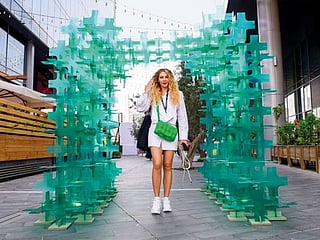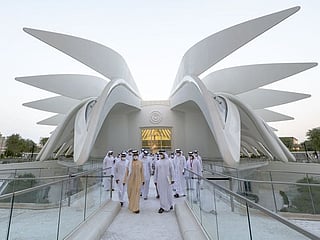Rare early Islamic silver coins on display at Louvre Abu Dhabi from tomorrow
Hoard of Jazira pieces have been preserved for two years before display

Abu Dhabi: A rare collection of early Islamic civilisation silver coins — the Hoard of Jazira — will be on display at Louvre Abu Dhabi tomorrow.
The set of more 2,861 coins, dating back to the reign of King Shapur II (309-379 AD) and until the governance of Abbasid Caliph Al Ma’mun (813-833 AD), has been conserved for two years, ever since it was acquired by the Abu Dhabi-based museum in 2019. It will be on display, along with 67 additional single coins in gold or gold alloy that were produced in the Mediterranean basin and Eurasia between the 6th and 16th centuries.
In a statement, Louvre Abu Dhabi said the “coins reveal regional and local history, signifying political changes, power struggles and the changing value places on precious metals during these periods”.
Monetary history
“This display will showcase a global monetary history. It highlights the trade, cultural exchanges and political dynamics revealing an interconnected world economy between distant regions. It testifies to the birth of Islamic coinage and its evolution. The Sasanian drachmas, Umayyad dirhams, Abbasid silver coins, alongside the gold Byzantine solidus, the Genoese and Venetian gold coins, and more, will prove how a simple coin can illustrate power relationships and rivalries among competing, growing empires, as well as the emergence of major trade hubs,” said Guilhem Andre, the museum’s chief curator.
Careful conservation
The collection is named after the area where the coins were minted: The Jazira or island refers loosely to upper Mesopotamia, which today comprises northwestern Iraq, northeastern Syria and southeastern Turkey. Louvre Abu Dhabi previously reported that the collections had been acquired from a private collector in Europe.
‘Coins documented and digitised’
Theofanis Karafotias, head of preventive conservation at the museum, said an extensive conservation process had been carried out before the public display.
“The coins were not only conserved by the museum, but also documented and digitised as well so that they could be studied in greater detail. We also had to decide on how to conserve each coin among the thousands, such as whether chemicals, an ultrasonic bath, or simple distilled water treatment would be the best — the least intrusive way to reveal each coin’s face,” he explained.
The craftsmanship, stamping and minting of coins was inherited from the Byzantine and Sasanian empires, and this hoard shows that period of transition. The coinage of the Byzantine and the Sasanian empires had representations of the divine, but this was a way for the Islamic rulers to link their political and religious power to the currency by changing that.Souraya Nujaim, director for scientific, curatorial and collections management, Louvre Abu Dhabi
Financial centres
When unveiled, the new presentation will be dedicated to the financial centres that came into existence during the medieval period and their monetary systems. The diffusion of specific gold and silver coins and the trade of precious metals created the pre-conditions for the economy of the modern world, a practise that later had a considerable impact on the global economy. The new display will therefore shed light on the transcontinental trade of gold and silver. The stylistic development of these coins also works as an indicator of their evolving values in accordance with time and shifting geographies.
Louvre Abu Dhabi also has a number of other coins in its numismatic collection, with many precious pieces on display in a dark room. Glass cases that are carefully lit showcase the coins, which date back to ancient Greece and China.
Significance of collection
Speaking to an international media outlet about the cache of coins, Souraya Nujaim, director for scientific, curatorial and collections management at the museum, said it is “extremely rare to acquire such an amount of undocumented history”. She added that the coins represented the shifting face of trade in the era, a consolidation largely attributed to Abdel al-Malik, the fifth Umayyad caliphate, who also initiated major changes in the visual symbols on coins and created a single Islamic currency in 693AD.
“The craftsmanship, stamping and minting of coins was inherited from the Byzantine and Sasanian empires, and this hoard shows that period of transition. The coinage of the Byzantine and the Sasanian empires had representations of the divine, but this was a way for the Islamic rulers to link their political and religious power to the currency by changing that,” she explained.
Preservation and record
Conservators at the museum have recorded each coin’s weight, diameter and thickness and photographed its front and back before beginning the restoration process. This can also help historians understand how coinage evolved and how metal combinations have shifted in coinage over time. In addition, it helps understand the use of various symbols and images in coinage, which include the portraits of rulers, names of rulers and even texts from the holy Quran.
Karafotias said that the coins, although considered silver, also contain some copper in their composition, which corrodes easily.
“Humidity and temperature both affect the rate of corrosion. Sulphur, fossil fuels, paint, wood, felt — all of these can have an impact on corrosion. Another factor is inappropriate previous treatment,” he explained.
These details will be added to an international database so that museums and other collectors can compare them with other pieces.
Sign up for the Daily Briefing
Get the latest news and updates straight to your inbox








